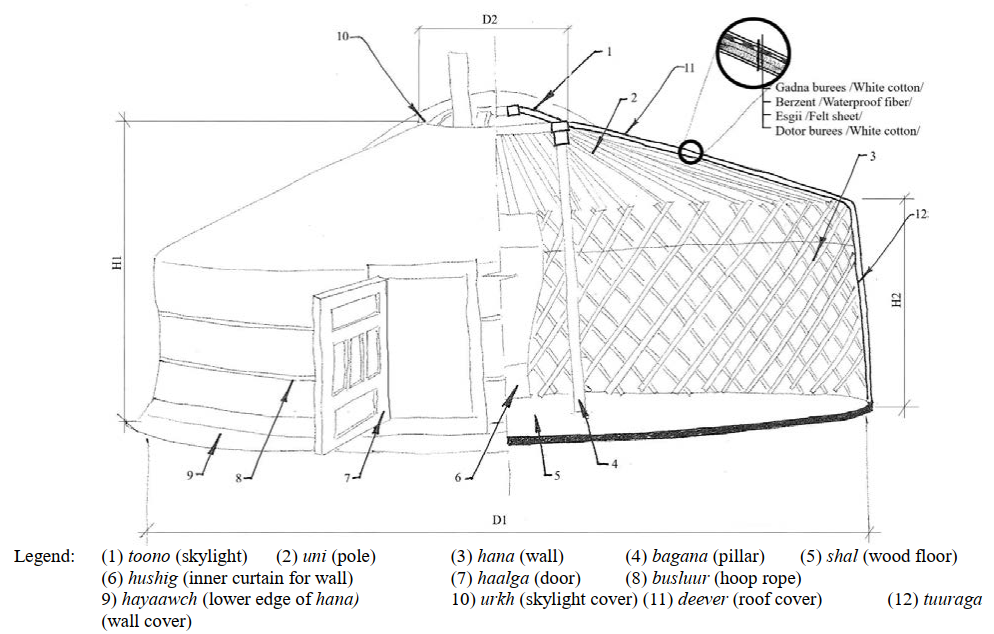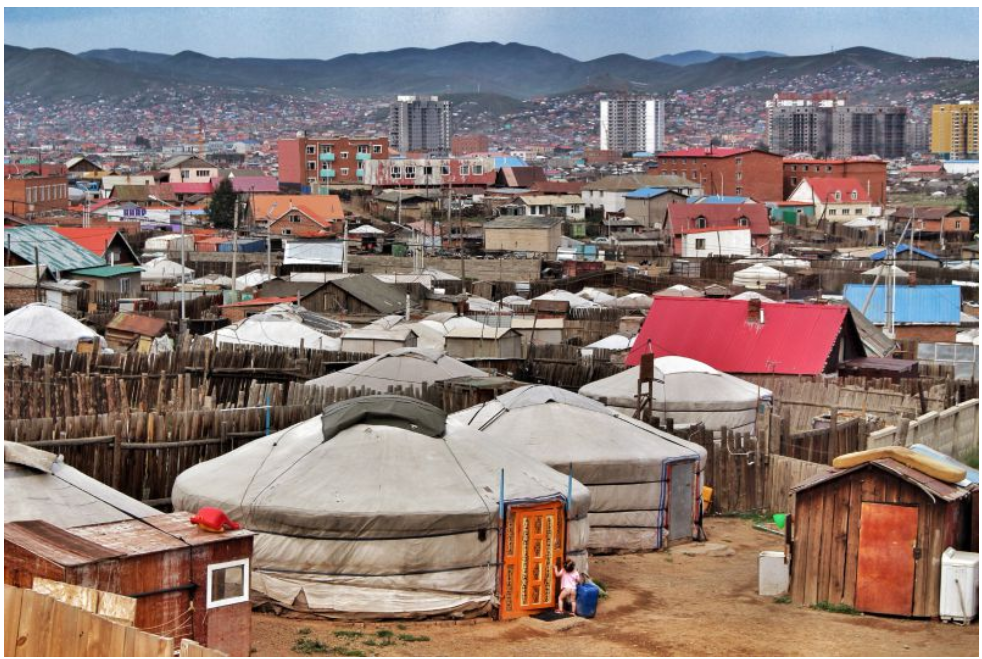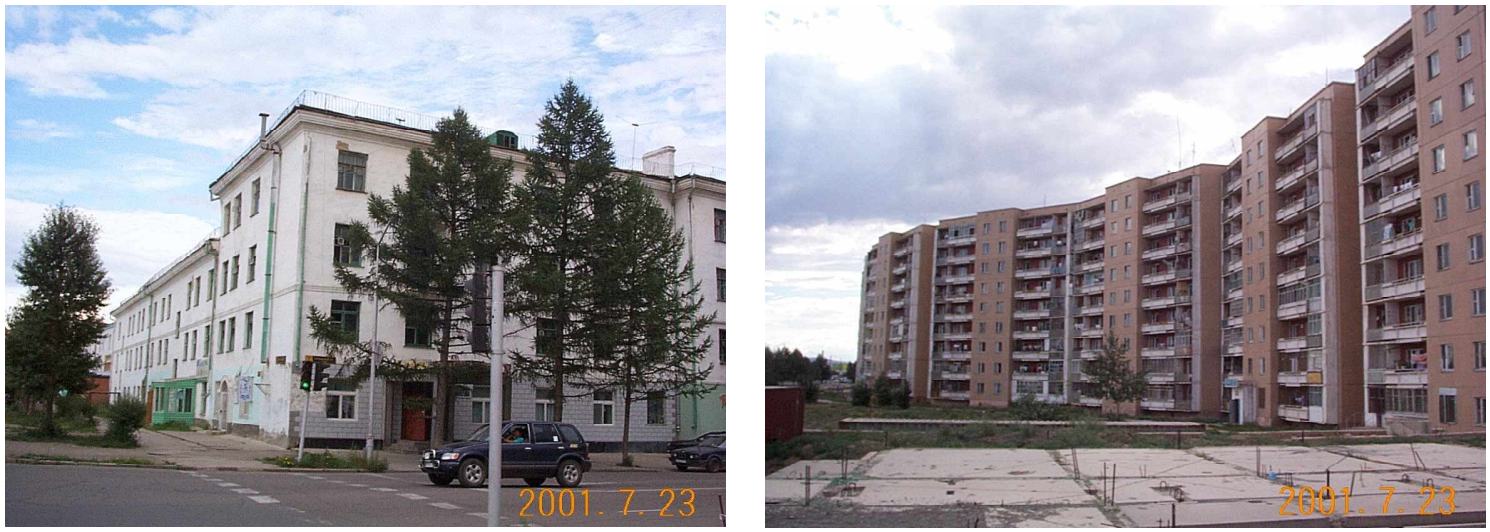Construction practices#
Mongolia#
In the last decades, the rapid urbanisation in Mongolia led to an exponential increase in the urban population of the country, mainly concentrated in the Ulaanbaatar region. These rural migrants populated the so-called “ger districts”, unplanned settlements that sprawl around the capital city. Gers, the traditional nomadic Mongolian dwelling, consist of round portable tents made of wooden poles covered with durable and waterproof sheets, as seen in the images below. Due to its structure, these dwelling typically show very low vulnerability to seismic actions. Gers are the most common type of building, not only in the area around Ulaanbaatarm but also in rural areas, where about 65% of the households live in gers.


According to Dorjpalam et al. (2004), “in general there are six major structural types that constitute the stock of buildings” in urban areas and in particular in Ulaanbaatar. “These are masonry structures with thick load bearing brick walls (see left image below), cast-in-place reinforced concrete (RC) frame structures, pre-cast panel structures that combine several RC-panels of factory-made walls (see right image below), steel structures, wooden structures and gers (traditional tent like structures). However, the first three building types occupy the main stock of so-called engineered buildings.”

“Masonry buildings in UB, which are usually apartments, appeared sound and seismically safe, but the reckless modification on the first floor to use them as a service space such as shops or restaurants, makes the building weaker for seismic resistance.”
“Pre-cast RC-panel structures are also mostly represented by the apartment buildings. The main weakness of this type of structure seems to lie in the connections between wall panels, which are welded steel bar filled with concrete. This connection could break suddenly once the deformation exceeds a certain threshold. The weackness of cast-in-place moment-resistant frame buildings lies in the length of shear-resistand walls, which are usually very short and poor quality as cast-in-place structural members.”
“Besides these three types of buildings, there are a large number of owner-built, non-engineered buildings such as detached, wooden or masonry buildings, and Gers.”
Russia#
According to the national statistics, households in urban areas primarily live in apartments (77%) whereas households in rural areas primarily live in individual houses (70%). Blocked houses (or row houses) are also found in both urban areas (3%) and rural areas (9%).
The 2019 Census included information regarding the primary wall material of residences. The identified categories and their distribution are: Brick (38%), Panels (24%), Wood (17%), Blocks (7%), Mixed (5%), Other (4%), Monolith (3%), and Stone (2%). The distribution of materials by subnational area is shown in the images below.




A notable feature of the residential building stock in Russia is the prevalence of large panel buildings. These panel buldings vary by generation (UNECE 2004):
Between 1959-1969: 5-storey khrushchevky with 30-61 square meter dwelling areas; often far from city centres and in a poor state of repair
Between 196101975: ~9-storey buildings; long and with lightweight concrete external walls
After 1975: 9+ storey buildings using large prefabricated elements and lightweight concrete external walls; often in suburbs; loq quality construction and in poor maintenace
References#
UNECE. Country Profiles on the Housing Sector: Russian Federation. 2004. Available at: https://unece.org/housing-and-land-management/publications/country-profiles-housing-sector-russian-federation
Dorjpalam S, Kawase H, Ho N (2004) “Earthquake disaster simulation for Ulaanbaatar, Mongolia based on the field survey and numerical modeling of masonry buildings”, 13th World Conference on Earthquake Engineering, Vancouver, B.C., Canada
Purev U, Hagishima A (2020) “A Field Survey of Traditional Nomadic Dwelling Gers Used as Urban Habitats in Ulaanbaatar, Mongolia” EVERGREEN Joint Journal of Novel Carbon Resource Sciences & Green Asia Strategy, Vol. 07, Issue 02, pp155-171